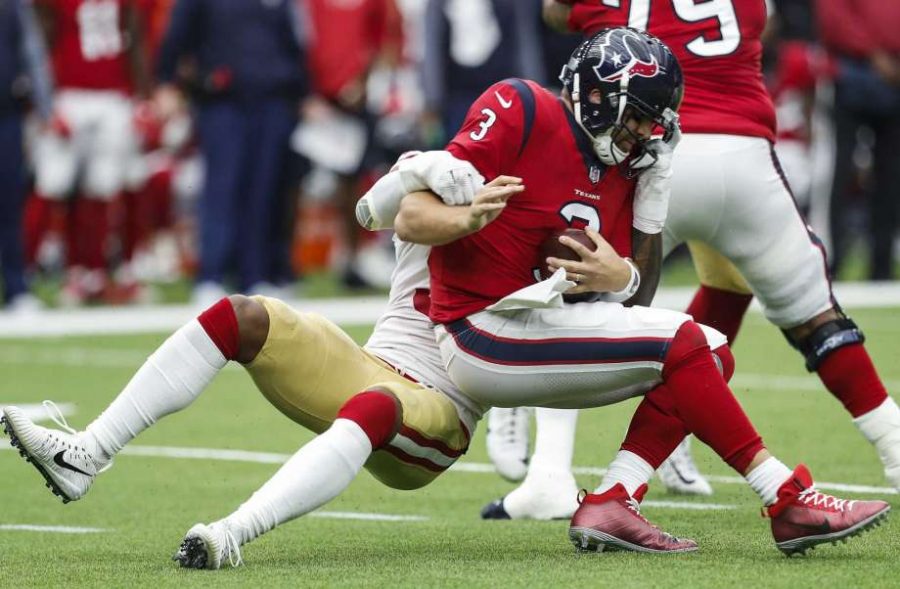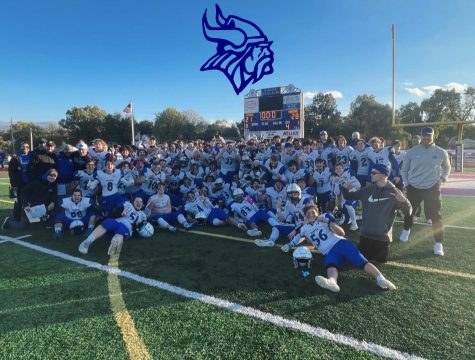The real toll of football: more than concussions
Last Sunday, Houston Texans quarterback Tom Savage fell into his own end zone after a punishing hit delivered by a 49ers defensive lineman. Spectators would have thought, however, that he was lying on an electric shock machine. Savage awkwardly rolled over, stared blankly at the sideline, and reached out his trembling hands. He seemed possessed. Supporters of both sides most likely thought they had seen the end of Savage’s season. Moreover, it is certain that every fan watching was baffled when Savage later came trotting out of the tunnel and nervously snapped his helmet on. Despite millions of people in collective confusion and disagreement with the decision, Tom Savage was back on the battlefield. Um, who was in charge of this guy’s protocol testing?
As gruesome and horrific as it was to see Savage’s upper body involuntarily shake, it simply is not close to being in the discussion of the most disgusting football injuries of the 21st century; there is too much competition. Take the Sunday just seven days prior-Steelers linebacker Ryan Shazier was rushed off Heinz Field to the nearest hospital after suffering a devastating spinal injury. Shazier is still in the hospital and undergoing spinal surgery, merely hoping he can walk again. All the snapped tibias and bent femurs aside, modern football has witnessed too many brain and spinal tragedies to keep track of.
Take a look at some of the astounding numbers. In the last five NFL seasons, 1,215 concussions were diagnosed (NFL Concussions). Considering the multitude of other traumatic situations that went unseen, that number is incredibly daunting. These repeated, brain damaging hits players routinely suffer game to game is amounting to conditions far more severe than a temporary concussion. Several former NFL players have committed suicide as a direct cause of the trauma they suffered throughout their careers. (NFL Concussions). One suicide in particular played a pivotal piece in the hunt to understand brain damage to the fullest. In 2002, Dr. Bennet Omalu, a co-founder of the Brain Injury Research Institute, identified chronic traumatic encephalopathy (CTE) in the brain of former Pittsburgh Steelers’ center Mike Webster. Webster had killed himself at age 50. It was in this autopsy that CTE had first been discovered, and nearly every suicide since Webster’s has been connected to a severe case of the condition. CTE has not only been discovered in every former NFL player suicide case, it has been proven that 99% of all NFL players who compete for an average of fifteen years develop this critical condition.
The problem is obvious. Nearly everyone playing in the NFL for a significant amount of time leaves with CTE. CTE leads to suicides, early deaths, mental illnesses, etc. It is a simple equation to follow, which also means it is going to be difficult to find an alternative one. Everyone loves the NFL; it is a massive element of the American culture and economy, football certainly can not end. So what else do we do, just let the players play and hope for the best?
A bit of a roadblock stands in the way- CTE can only be discovered through neurosurgical examination after the player has died (NFL Concussions). Nonetheless, it is still up to the NFL to determine the percentage of players being found with CTE following their inevitably shortened lives, and tame this monumental threat. The impacts and trauma the players are receiving game to game can, and should, be assertively controlled by the NFL. A logical first step would be to devote a larger portion of the NFL’s earnings to the engineering of stronger, safer helmets. Helmets with higher levels of technology would be able to communicate when impacts above a certain threshold have been received, alerting doctors and trainers that a player needs attention. The NFL would also benefit from an immediate rule tightening. The laws must be enforced with more authority and safety-first mentality. Any player exemplifying visible symptoms of brain trauma, such as Tom Savage resembling an electrocuted zombie, that player should be withdrawn from the game, no questions asked. If concussion protocol is executed properly, not passively, and helmet technology and structure are tremendously improved by engineers and doctors, we could begin to see a decrease in NFL stars becoming CTE victims. These players deserve a normal, healthy, long life no less than any of the fans they lay their life on the line for.
Works Cited
“NFL Concussions Fast Facts”. CNN Library. CNN. Nov. 28, 2017. Web. Dec. 13, 2017.










